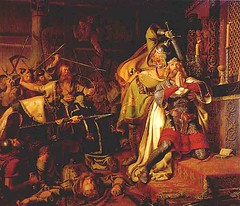
The Murder of Canute the Holy
Originally uploaded by summoning_ifrit
Knud den Helliges drab (The Murder of Canute the Holy) by Christian Albrecht von Benzon, c. 1843.
Canute IV: was the illegitimate son of Sweyn II Estridsson. Before he became king of Denmark, the Anglo-Saxon Chronicle reports that Canute was one of the leaders of a Viking raiding expedition against England in 1075. On its return from England, the Danish raiders' fleet stopped in the County of Flanders. Because of its hostility toward William I of England, Flanders was a natural ally for the Danes.
In 1080, Canute succeeded his brother, Harald III, to the throne of Denmark. On his accession, he married Adela, daughter of Robert I, Count of Flanders. She bore him one son, Charles, a name uncommon in Denmark. The boy later became Count of Flanders and was known as Charles the Good, ruling from 1119 to 1127. Like his father, he was martyred in a church by rebels (in Bruges in 1127).
Canute quickly proved himself to be a highly ambitious king as well as a devout one. His reign was marked by vigorous attempts to increase royal power in Denmark. He issued edicts arrogating to himself the ownership of common land, the right to the goods from shipwrecks, and the right to inherit the possessions of foreigners and kinless folk. Ever a champion of the Church, he also issued laws to protect the weak, orphans, widows, and foreigners, and tried to enforce the collection of tithes. These policies led to discontent among his subjects, who were unaccustomed to a king who claimed such powers and who interfered in their daily lives.
But Canute's ambitions were not purely domestic. As the grandnephew of Canute the Great, who until 1035 was king of England, Denmark and Norway, this Canute considered the crown of England to be rightfully his. He therefore regarded William I of England as a usurper. In 1085, with the support of his father-in-law Count Robert, Canute planned an invasion of England. He assembled a fleet at Limfjord, but it never set sail. Possibly Canute was wary of intervention by Henry IV, Holy Roman Emperor, with whom both Denmark and Flanders were on unfriendly terms. Certainly Canute was suspicious of his brother Olaf (later Olaf I of Denmark), who sought command of the fleet, and had him arrested and sent to Flanders. The fleet then dispersed, but Canute intended to reassemble it in a year's time.
Before the fleet could reassemble, a peasant revolt broke out in southern Jutland, where Canute was staying, in early 1086. Canute and his men took refuge inside the wooden Church of St. Alban's in Odense. But the rebels stormed into the church and slew Canute, along with his brother Benedict and seventeen of their followers, before the altar on July 10, 1086. According to Niels Lund, Lecturer in Medieval History at the University of Copenhagen, Canute's abortive invasion of England "marked the end of the Viking Age." For it was the last time a Viking army was to assemble against Western Europe. - enWikipedia

No comments:
Post a Comment